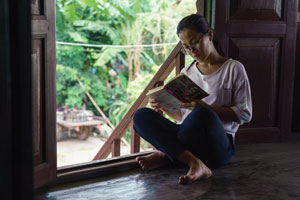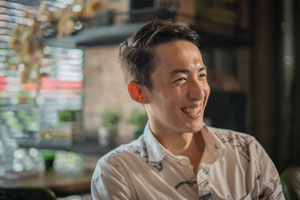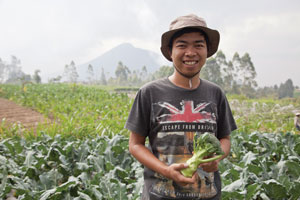Passing the Baton
With brighter prospects than their parents had, Southeast Asian youth get ready to take on the world
Jeremiah Overman, Vina Salazar, and Gembong Nusantara

More than half of the population of Southeast Asia is under 30. Technology shapes the way youth in the region live and work, even as they adapt it to their own unique circumstances. In some ways, these young people will inherit a better world than their parents knew, with higher income potential, increased access to education, and vast technological possibilities. They'll also face serious issues, such as the problem of climate change and challenges to openness and human rights. The following profiles offer a glimpse at the lives of three young Southeast Asians as they pursue their dreams of the future.
Bright lights, big city
Sreynith Hak is something of an oddball. Her friends from the village where she grew up have mostly all coupled up, some in arranged marriages. “I don’t judge them, because they are happy.” But that is not the life for her.

Hak, 25, moved to Phnom Penh eight years ago to pursue a bachelor’s degree in media management. “I like to hear people’s stories,” the freelance editor and film producer says. Cambodia’s capital offered her much more opportunity than the small town where her parents and siblings still live. “I can see more of the world; I can do what I want,” she says.
Hak is well educated, which sets her apart from many Cambodian women in the labor force. In 2014, 84 percent of employed women 15 and older had a primary school education or less, compared with 76 percent of employed men, according to the Asian Development Bank’s Promoting Women’s Economic Empowerment in Cambodia.
As a freelancer, Hak ekes out a living, taking care to set money aside from month to month in case her pipeline of projects runs dry. “You have to be flexible in how much you spend each month,” she says. Her modest income allows for simple pleasures— going to exhibitions, doing yoga, ordering dinner through an app, saving up for travel.
Hak is not alone in seeking a better life in the big city. Nearly 60 percent of rural migrant women move to Phnom Penh, says the Asian Development Bank. But even though poverty rates have fallen, Cambodian girls and women experience greater vulnerability as a result of prevailing social norms and have less access to resources and job opportunities than boys and men.
Strong and independent, Hak too has felt vulnerable. Women and men are not yet equal in Cambodia, she says. Sometimes when working on the set of a video shoot, she returns home late at night and faces harassment from men on the street. She says her parents would rather see her in a salaried position, leading a more conventional life.
But Hak’s mother, a teacher whose parents were killed by the Khmer Rouge, accepts her choice. Aware that her daughter’s prospects are far more promising than hers at the same age, she doesn’t pressure her to move back home. She is content to see her daughter on the occasional visit to her hometown, which has become easier now that the roads are better.
Hak is patient, relishing life in the capital but driven by the desire to achieve career success one day. “I have my own timeline, my own clock,” Hak says. “I want to prove to people that I can do it—maybe even better than some guy.”
Reported by JEREMIAH OVERMAN, Phnom Penh, Cambodia
The last straw
Pocholo Espina, 22, always thought he would grow up to be a doctor or lawyer. Instead, the young Manila resident is the founder and CEO of Sip PH, a company that makes and distributes stainless steel straws.

It all started when Espina was a student at Ateneo de Manila University. He got interested in the zero-waste movement, which promotes a lifestyle that minimizes the amount of waste sent to landfills by encouraging the reuse of products. Espina had difficulty finding a metal straw for his own use. So he purchased some in bulk and sold the rest, discovering that there was strong demand for the product. Investing 40,000 pesos of his savings, he started a company to produce reusable metal straws for environmentally conscious consumers.
Sip is still a small-scale business, but Espina has gone from a tiny customer base built by word of mouth to thousands of orders through social media and via a few shops in Manila. Earlier this year, he was interviewed on CNN Philippines.
Espina practices skin diving and sees it as a personal mission to keep his country’s oceans and waterways clean. “The Philippines is at the very center of marine biodiversity in the world,” he says. Composed of 7,641 islands, the country is located in the “Coral Triangle,” an area recognized as the global center of marine biodiversity. It includes portions of the waters of the Philippines, Malaysia, Indonesia, Timor-Leste, Papua New Guinea, and the Solomon Islands.
The area’s marine life comprises not just coral reefs but also seagrass beds, mangrove and beach forests, fisheries, other invertebrates, seaweed, and marine mammals. “Once you see its beauty firsthand, you’d understand why you have a pretty good reason for protecting it,” Espina says.
The Philippines bans incineration of trash, and the disposal of solid waste poses a major challenge. (Sip PH’s website says that the Philippines is the third largest disposer of ocean plastic in the world.) Increasingly, the plastic waste problem is attracting the world’s attention—global coffeehouse chain Starbucks just announced its plan to phase out plastic straws, which are difficult to recycle, and others are following suit.
Espina's concern for the environment is typical of his generation. According to the World Economic Forum’s 2017 Global Shapers survey, nearly half of all young people rank climate change and the destruction of nature as the most serious issues affecting the world today. And the IMF finds that, in addition to its harmful effects on health, climate change has potentially sizable economic costs.
Rather than trying to tackle the broader problem of plastic waste, Espina decided to focus on a smaller, more manageable issue. Giving up plastic straws, he reckons, is a small sacrifice ordinary people can make every day.
Over the long term, Espina would like to get more involved in advocacy for the environment. For now, he’s had to focus on the bottom line. “People often ask, in a social enterprise, which is more important—the social aspect or the enterprise aspect? Well, it has to be the enterprise, because without that there wouldn’t be a social impact.”
Reported by VINA SALAZAR in Manila, Philippines
The future of farming
While many young Indonesians abandon rural areas for city life, Shofyan Adi Cahyono, 22, has decided to modernize his father’s farm in the highlands of central Java by embracing new technology and progressive farming methods.

Cahyono’s family has been farming for generations. Among the agricultural Javanese, land is something important to be passed down, a legacy for the next generation. “The soil here is very fertile because it is volcanic,” Cahyono says, displaying its crumbly texture.
“Farming is considered a low job,” he says, “but I am trying to change that.”
He initially resisted pressure to join the family business. But after studying agrotechnology at Satya Wacana Christian University, he has come around. His challenges are similar to those faced by the previous generation, he says, but now there are many more solutions. He and his family can use information technology to sell their products, eliminating the middleman. That way, “we can set competitive prices and make a higher profit,” Cahyono says. Their farm sells produce to restaurants, cafes, hotels, and supermarkets.
In the past, his father planted vegetables without calculating precisely the cost and profit. Today, Cahyono has access to produce distributors in every major city, using a preorder system that helps them manage production. “If customers want to buy our product, they leave a message for us through WhatsApp. Then we harvest it, pack it up, and send it off, and our produce remains in a fresh state until it gets to its destination,” he says.
Across Asia, farmers like Cahyono are starting to take advantage of the efficiencies to be gained from digital technology that provides more precise and timely information about markets, inventories, and crops. Some even use drones to capture images that can be analyzed to forecast yields, identify crop diseases, and assess fertilizer needs.
At the same time, organic farming is booming as Asia’s rising middle class grows wary of the health dangers posed by pesticides. A growing number of cafes and restaurants in Indonesia offer organic fruit and vegetables on their menus, creating an opportunity for farmers like Cahyono.
He also enjoys the creativity involved in planting a variety of organic vegetables. “My friends in the city get bored with going to work, coming home, and doing it over and over, with nothing creative in their day,” he says.
Cahyono wants to spread the word, educating other young people about progressive farming methods.
“I share my knowledge so that more people will know that the agricultural sector is promising,” he says. “Hopefully more young men will also be inspired to become farmers.”
Reported by GEMBONG NUSANTARA in Merbabu, Central Java, Indonesia
Opinions expressed in articles and other materials are those of the authors; they do not necessarily reflect IMF policy.









